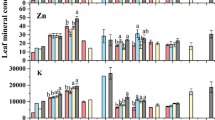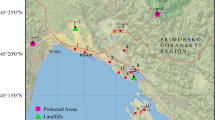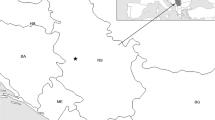Abstract
Foliar ionome, photosystem II activity, and leaf growth parameters of Ranunculus acris L., a potential biomonitor of trace element (TE) contamination and phytoavailability, were assessed using two riverbank soil series. R. acris was cultivated on two potted soil series obtained by mixing a TE (Cd, Cu, Pb, and Zn)-contaminated technosol with either an uncontaminated sandy riverbank soil (A) or a silty clay one slightly contaminated by TE (B). Trace elements concentrations in the soil-pore water and the leaves, leaf dry weight (DW) yield, total leaf area (TLA), specific leaf area (SLA), and photosystem II activity were measured for both soil series after a 50-day growth period. As soil contamination increased, changes in soluble TE concentrations depended on soil texture. Increase in total soil TE did not affect the leaf DW yield, the TLA, the SLA, and the photosystem II activity of R. acris over the 50-day exposure. The foliar ionome did not reflect the total and soluble TE concentrations in both soil series. Foliar ionome of R. acris was only effective to biomonitor total and soluble soil Na concentrations in both soil series and total and soluble soil Mo concentrations in the soil series B.





Similar content being viewed by others
Abbreviations
- b-CA:
-
b-Carbonic anhydrase
- CEC:
-
Cationic exchange capacity
- DGT:
-
Diffusive gradients in thin-film
- DOC:
-
Dissolved organic carbon
- DW:
-
Dry weight
- EC:
-
Electric conductivity
- EEA:
-
European Environmental Agency
- EXAFS:
-
Extended x-ray absorption fine structure
- F 0 :
-
Minimal fluorescence level in the dark adapted state
- F m :
-
Maximum fluorescence
- F v :
-
F m − F 0
- GACGC:
-
German Advisory Council on Global Change
- ISO:
-
International Organization of Standardization
- Kd:
-
Partition coefficient
- NRAMP:
-
Natural resistance-associated macrophage protein
- OM:
-
Organic matter
- PCA:
-
Principal component analysis
- PSII:
-
Photosystem II
- SLA:
-
Specific leaf area
- TE:
-
Trace element
- TLA:
-
Total leaf area
- VDLUFA:
-
Association of German Agricultural Analytic and Research Institutes
- WHC:
-
Water holding capacity
- XANES:
-
X-ray absorption near edge structure
References
Adriano DC (2001) Trace elements in terrestrial environments: biogeochemistry, bioavailability, and risks of metals, 2nd edn. Springer, Verlag
Alloway BJ (2008) Zinc in soils and crop nutrition. Second edition, Eds. IZA and IFA, Brussels, Belgium and Paris, France. 135 p. ISBN 978-90-8133-310-8. Available at http://www.zinc.org/general/Zinc_in_Soils_and_Crop_Nutrition_ALLOWAY.pdf
Alvim Ferraz MCM, Lourenço JCN (2000) The influence of organic matter content of contaminated soils on the leaching rate of heavy metals. Environ Prog 19:53–58. doi:10.1002/ep.670190118
Arrêté du 9 août 2006, relatif aux niveaux à prendre en compte lors d’une analyse de rejets dans les eaux de surface ou de sédiments marins, estuariens ou extraits de cours d’eau ou canaux relevant respectivement des rubriques 2.2.3.0, 4.1.3.0 et 3.2.1.0 de la nomenclature annexée au décret n° 93–743 du 29 mars 1993. Fr Off J 222 :14082–14085
Baize D, Deslais W, Saby N (2007) Teneurs en huit éléments traces (Cd, Cr, Cu, Hg, Ni, Pb, Se, Zn) dans les sols agricoles en France - Résultats d’un collecte de données à l’échelon national. ADEME - Gis Sol - INRA. 86 p
Barth JAC, Grathwohl P, Fowler HJ, Bellin A, Gerzabek MH, Lair GJ, Barcelo D, Petrovic M, Navarro A, Negrel P, Petelet-Giraud E, Darmendrail D, Rijnaarts H, Langenhoff A, de Weert J, Slob A, van der Zaan BM, Gerritse J, Frank E, Gutierrez A, Kretzschmar R, Gocht T, Steidle D, Garrido F, Jones KC, Meijer S, Moeckel C, Marsman A, Klaver G, Vogel T, Burger C, Kolditz O, Broers HP, Baran N, Joziasse J, Von Tumpling W, Van Gaans P, Merly C, Chapman A, Brouyere S, Aguilar JB, Orban P, Tas N, Smidt H (2009) Mobility, turnover and storage of pollutants in soils, sediments and waters: achievements and results of the EU project AquaTerra. A review. Agron Sustain Dev 29:161–173. doi:10.1051/agro:2007060
Bauer M, Blodau C (2006) Mobilization of arsenic by dissolved organic matter from iron oxides, soils and sediments. Sci Total Environ 354:179–190. doi:10.1016/j.scitotenv.2005.01.027
Bearup L, Mikkelson KM, Wiley JF, Navarre-Sitchler AK, Maxwell RM, Sharp JO, McCray JE (2014) Metal fate and partitioning in soils under bark beetle-killed trees. Sci Total Environ 496:348–367. doi:10.1016/j.scitotenv.2014.07.052
Beesley L, Moreno-Jiménez E, Clemente R, Lepp N, Dickinson N (2010) Mobility of arsenic, cadmium and zinc in a multi-element contaminated soil profile assessed by in-situ soil-pore water sampling, column leaching and sequential extraction. Environ Pollut 158:155–160. doi:10.1016/j.envpol.2009.07.021
Beesley L, Dickinson NM (2010) Carbon and trace element mobility in an urban soil amended with green waste compost. J Soils Sediments 10:215–222. doi:10.1007/s11368-009-0112-y
Belon E, Boisson M, Deportes IZ, Eglin TK, Feix I, Bispo AO, Galsomies L, Leblond S, Guellier CR (2012) An inventory of trace element inputs to French agricultural soils. Sci Total Environ 439:87–95. doi:10.1016/j.scitotenv.2012.09.011
Bert V, Lors C, Ponge JF, Caron L, Biaz A, Dazy M, Masfaraud JF (2012) Metal immobilization and soil amendment efficiency at a contaminated sediment landfill site: a field study focusing on plants, springtails, and bacteria. Environ Pollut 169:1–11. doi:10.1016/j.envpol.2012.04.021
Bes C, Mench M, Aulen M, Gasté H, Taberly J (2010) Spatial variation of plant communities and shoot Cu concentrations of plant species at a timber treatment site. Plant Soil 330:267–280. doi:10.1007/s11104-009-0198-4
Blum WEH, Horak O, Mentler A, Puschenreiter M (2012) UNESCO – EOLSS Environmental and Ecological chemistry – Vol.II – Trace elements. http://www.eolss.net/Sample-Chapters/C06/E6-13-03-04.pdf (verified on October, 1, 2014)
Bonanno G (2013) Comparative performance of trace element bioaccumulation and biomonitoring in the plant species Typha domingensis, Phragmites australis and Arundo donax. Ecotoxicol Environ Saf 97:124–130. doi:10.1016/j.ecoenv.2013.07.017
Bourdot GW, Lamoureaux SL, Watt MS, Kriticos DJ (2013) The potential global distribution of tall buttercup (Ranunculus acris ssp. acris): opposing effects of irrigation and climate change. Weed Sci 61:230–238. doi:10.1614/WS-D-12-00106.1
Burbridge DJ, Koch I, Zhang J, Reimer KJ (2012) Chromium speciation in river sediment pore water contaminated by tannery effluent. Chemosphere 89:838–843. doi:10.1016/j.chemosphere.2012.05.005
Burt R, Hernandez L, Shaw R, Tunstead R, Ferguson R, Peaslee S (2014) Trace element concentration and speciation in selected urban soils in New York City. Environ Monit Assess 186:195–215. doi:10.1007/s10661-013-3366-1
Cambrollé J, Mancilla-Leytón JM, Muñoz-Vallés S, Luque T, Figueroa ME (2012) Zinc tolerance and accumulation in the salt-marsh shrub Halimione portulacoides. Chemosphere 86:867–874. doi:10.1016/j.chemosphere.2011.10.039
Caporale AG, Pigna M, Dynes JJ, Cozzolino V, Zhu J, Violante A (2011) Effect of inorganic and organic ligands on the sorption/desorption of arsenate on/from Al-Mg and Fe-Mg layered double hydroxides. J Hazard Mater 198:291–298. doi:10.1016/j.jhazmat.2011.10.044
Capra GF, Coppola E, Odierna P, Grilli E, Vacca S, Buondonno A (2014) Occurrence and distribution of key potentially toxic elements (PTEs) in agricultural soils: a paradigmatic case study in an area affected by illegal landfills. J Geochem Explor 145:169–180. doi:10.1016/j.gexplo.2014.06.007
Chaney RL (1989) Toxic element accumulation in soils and crops: protecting soil fertility and agricultural food chains. In: Bar-Yosef B, Barrow NJ, Goldshmid J (eds) Inorganic contaminants in the Vadose Zone. Springer, Berlin, pp 140–158
D’Alessandro A, Taamalli M, Gevi F, Timperio AM, Zolla L, Ghnaya T (2013) Cadmium stress responses in Brassica juncea: hints from proteomics and metabolomics. J Proteome Res 12:4979–4997. doi:10.1021/pr400793e
Davison W, Zhang H (2012) Progress in understanding the use of diffusive gradients in thin films (DGT)—back to basics. Environ Chem 9:1–13. doi:10.1071/EN11084
Defra (2012) Environmental Protection Act 1990: part 2A, contaminated land statutory guidance April 2012. PB13735 Defra, London, UK. https://www.gov.uk/government/publications/contaminated-land-statutory-guidance (accessed March 2015)
Delmail D (2014) Risk management of European inland waters using macrophyte biomonitoring. Front Environ Sci. doi:10.3389/fenvs.2014.00031
European Environmental Agency (2014) Progress in management of contaminated sites (LSI 003)—assessment published May 2014. Copenhagen, Denmark: European Environmental Agency. Available at http://www.eea.europa.eu/data-and-maps/indicators/progress-in-management-of-contaminated-sites-3/assessment#toc-2 on October 7, 2104.
Evangelou MWH, Robinson BH, Conesa HM, Schulin R (2012) Biomass production on trace element (TE) contaminated land—a review. Environ Eng Sci 29:823–839. doi:10.1089/ees.2011.0428
GACGC (1995) World in transition: the threat to soils. Annual report—1994. German Advisory Council on Global Change, Bonn
GIS sol (2009) Nouvelle collecte nationale d’analyses d’éléments traces métalliques - Statistiques par région agricole. Available at http://www.gissol.fr/programme/bdetm/Collecte_2/index.php. Access on October 7, 2014
Goldberg S (2002) Competitive adsorption of arsenate and arsenite on oxides and clay minerals. Soil Sci Soc Am J 66:413–421. doi:10.2136/sssaj2002.4130
Grafe M, Donner E, Collins RN, Lombi E (2014) Speciation of metal(loid)s in environmental samples by X-ray absorption spectroscopy: a critical review. Anal Chim Acta 822:1–22. doi:10.1016/j.aca.2014.02.044
Hassan Z, Aarts GM (2011) Opportunities and feasibilities for biotechnological improvement of Zn, Cd or Ni tolerance and accumulation in plants. Environ Exp Bot 72:53–63. doi:10.1016/j.envexpbot.2010.04.003
Hoagland DR, Arnon DL (1950) The water culture method for growing plants without soil. California agricultural experiment station. Circular 347
ISO 11269-2 (2005) Soil quality. Determination of the effects of pollutants on soil flora. Effects of chemicals on the emergence and growth of higher plants. ISO/TC 190/SC 4
ISO 17512-1 (2008) Soil quality—avoidance test for determining the quality of soils and effects of chemicals on behaviour—part 1: test with earthworms (Eisenia fetida and Eisenia andrei). ISO/TC 190/SC 4
ISO 10872 (2010) Water quality—determination of the toxic effect of sediment and soil samples on growth, fertility and reproduction of Caenorhabditis elegans (Nematoda). ISO/TC 147/SC 5
Japenga J, Koopmans GF, Song J, Romkens PFAM (2007) A feasibility test to estimate the duration of phytoextraction of heavy metals from polluted soils. Int J Phytorem 9:115–132. doi:10.1080/15226510701232773
Kabala C, Karczewska A, Medynska-Juraszek A (2014) Variability and relationships between Pb, Cu, and Zn concentrations in soil solutions and forest floor leachates at heavily polluted sites. J Plant Nutr Soil Sci 177:573–584. doi:10.1002/jpln.201400018
Kalbitz K, Wennrich R (1998) Mobilization of heavy metals and arsenic in polluted wetland soils and its dependence on dissolved organic matter. Sci Total Environ 209:27–39. doi:10.1016/S0048-9697(97)00302-1
Karami N, Clemente R, Moreno-Jiménez E, Lepp NW, Beesley L (2011) Efficiency of green waste compost and biochar soil amendments for reducing lead and copper mobility and uptake to ryegrass. J Hazard Mater 191:41–48. doi:10.1016/j.jhazmat.2011.04.025
Kidd P, Mench M, Álvarez-López V, Bert V, Dimitriou I, Friesl-Hanl W, Herzig R, Janssen JO, Kolbas A, Müller I, Neu S, Renella G, Ruttens A, Vangronsveld J, Puschenreiter M (2014) Agronomic practices for improving gentle remediation of trace-element-contaminated soils. Int. J. Phytoremediation (accepted, BIJP-2014-0174).
Kolbas A, Mench M, Marchand L, Herzig R, Nehnevajova E (2013) Phenotypic seedling responses of a metal-tolerant mutant line of sunflower growing on a Cu-contaminated soil series: potential uses for biomonitoring of Cu exposure and phytoremediation. Plant Soil 376:377–397. doi:10.1007/s11104-013-1974-8
Kumpiene J, Bert V, Dimitriou I, Eriksson J, Friesl-Hanl W, Galazka F, Herzig R, Janssen JO, Kidd P, Mench M, Muller I, Neu S, Oustriere N, Puschenreiter M, Renella G, Roumier PH, Siebielec G, Vangronsveld J, Manier N (2014) Selecting chemical and ecotoxicological test batteries for risk assessment of trace element-contaminated soils (phyto)managed by gentle remediation options (GRO). Sci Total Environ 496:510–522. doi:10.1016/j.scitotenv.2014.06.130
Li L, Holm PE, Marcussen H, Bruun Hansen HC (2014) Release of cadmium, copper and lead from urban soils of Copenhagen. Environ Pollut 187:90–97. doi:10.1016/j.envpol.2013.12.016
Lin YF, Aarts MGM (2012) The molecular mechanism of zinc and cadmium stress response in plants. Cell Mol Life Sci 69:3187–3206. doi:10.1007/s00018-012-1089-z
Manzano R, Penalosa JM, Esteban E (2014) Amendment application in a multi-contaminated mine soil: effects on trace element mobility. Water Air Soil Pollut 225:1874–1884. doi:10.1007/s11270-014-1874-4
Marchand L, Mench M, Marchand C, Lecoustumer P, Kolbas A, Maalouf JP (2011) Phytotoxicity testing of lysimeter leachates from aided phytostabilized Cu-contaminated soils using duckweed (Lemna minor L.). Sci Total Environ 411:146–153
Marchand L, Nsanganwimana F, Vystavna Y, Huneau F, Lecoustumer P, Lamy JB, Cook B, Mench M (2014) Trace element transfer from soil to leaves of macrophytes along the Jalle d’Eysines River, France and their potential use as contamination biomonitors. Ecol Indic 46:425–437. doi:10.1016/j.ecolind.2014.07.011
Markert B (2007) Definitions and principles for bioindication and biomonitoring of trace metals in the environment. J Trace Elem Med Biol 21:77–82
Marschner P (2011) Mineral nutrition of higher plants, 3rd edn. Academic, London
Maxwell K, Johnson GN (2000) Chorophyll fluorescence—a practical guide. J Exp Bot 51:659–668. doi:10.1093/jexbot/51.345.659
McLaughlin MJ, Singh BR (1999) Cadmium in soil and plants. Kluwer Academic Publishing, Dordrecht
Mench MJ, Manceau A, Vangronsveld J, Clijster H, Mocquot B (2000) Capacity of soil amendments in lowering the phytoavailability of sludge-borne zinc. Agronomie 20:383–397. doi:10.1051/agro:2000135
Meers E, Ruttens A, Geebelen W, Vangronsveld J, Samson R, Vanbroekhoven K, Vandegehuchte M, Diels L, Tack FMG (2006) Potential use of the plant antioxidant network for environmental exposure assessment of heavy metals in soils. Environ Monit Assess 120:243–267. doi:10.1007/s10661-005-9059-7
Moreno-Jiménez E, Beesley L, Lepp NW, Dickinson NM, Hartley W, Clemente R (2011) Field sampling of soil-pore water to evaluate trace element mobility and associated environmental risk. Environ Pollut 159:3078–3085. doi:10.1016/j.envpol.2011.04.004
Nolan AL, Zhang H, McLaughlin MJ (2005) Prediction of zinc, cadmium, lead, and copper availability to wheat in contaminated soils using chemical speciation, diffusive gradients in thin films, extraction, and isotopic dilution techniques. J Environ Qual 34:496–507. doi:10.2134/jeq2005.0496
Pottier M, Masclaux-Daubresse C, Yoshimoto K, Thomine S (2014) Autophagy as a possible mechanism for micronutrient remobilization from leaves to seeds. Front Plant Sci 5(11):1–8. doi:10.3389/fpls.2014.00011
Rashti MR, Esfandbod M, Adhami E, Srivastava P (2014) Cadmium desorption behaviour in selected sub-tropical soils: effects of soil properties. J Geochem Explor 144(B):230–236. doi:10.1016/j.gexplo.2014.01.023
Schmitz J, Schafer K, Bruhl CA (2013) Agrochemicals in field margins—assessing the impacts of herbicides, insecticides, and fertilizer on the common buttercup (Ranunculus acris). Environ Toxicol Chem 32:1124–1131. doi:10.1002/etc.2138
Semane B, Dupae J, Cuypers A, Noben JP, Tuomainen M, Tervahauta A, Kärenlampi S, Van Belleghem F, Smeets K, Vangronsveld J (2010) Leaf proteome responses of Arabidopsis thaliana exposed to mild cadmium stress. J Plant Physiol 167:247–254. doi:10.1016/j.jplph.2009.09.015
Tipping E, Lofts S, Lawlor AJ (1998) Modelling the chemical speciation of trace metals in the surface waters of the Humber system. Sci Total Environ 210–211:63–77. doi:10.1016/S0048-9697(98)00045-X
Violante A, Huang PM, Gadd GM (2008) Biophysico-chemical processes of heavy metals and metalloids in soil environments. Wiley, Hoboken, 678 pp
Violante A, Cozzolino V, Perelomov L, Caporale AG, Pigna M (2010) Mobility and bioavailability of heavy metals and metalloids in soil environments. J Soil Sci Plant Nutr 10:268–292. doi:10.4067/S0718-95162010000100005
Vystavna Y, Huneau F, Grynenko V, Vergeles Y, Celle-Jeanton H, Tapie N, Budzinski H, Le Coustumer P (2012) Pharmaceuticals in rivers of two regions with contrasted socio-economic conditions: occurrence, accumulation, and comparison for Ukraine and France. Water Air Soil Pollut 223:2111–2124. doi:10.1007/s11270-011-1008-1
Wang S, Mulligan CN (2006) Effect of natural organic matter on arsenic release from soils and sediments into groundwater. Environ Geochem Health 28:197–214. doi:10.1007/s10653-005-9032-y
Washa M, Bini C, Zilioli D, Spiandorello M, Gallo M (2014) Potentially harmful elements in terraced agroecosystems of NE Italy: geogenic vs anthropogenic enrichment. J Geochem Explor 144:355–362. doi:10.1016/j.gexplo.2014.01.012
Wells ML, Kozelka PB, Bruland KW (1998) The complexation of “dissolved” Cu, Zn, Cd and Pb by soluble and colloidal organic matter in Narragansett Bay. RI Mar Chem 62:203–217. doi:10.1016/S0304-4203(98)00041-3
Wu J, Wang L, Ma F, Yang J, Li S, Li Z (2013) Effects of vegetative-periodic-induced rhizosphere variation on the uptake and translocation of metals in Phragmites australis (Cav.) Trin ex, Steudel growing in the Sun Island wetland. Ecotoxicol 22:608–618. doi:10.1007/s10646-013-1052-2
Yan LG, Xu YY, Yu HQ, Xin XD, Wei Q, Du B (2010) Adsorption of phosphate from aqueous solution by hydroxy-aluminum, hydroxy-iron and hydroxy-iron-aluminum pillared bentonites. J Hazard Mater 179:244–250. doi:10.1016/j.jhazmat.2010.02.086
Yruela I (2013) Transition metals in plant photosynthesis. Metallomics 5:1090–1109. doi:10.1039/c3mt00086a
Zhou QF, Zhang JB, Fu JJ, Shi JB, Jiang GB (2008) Biomonitoring: an appealing tool for assessment of metal pollution in the aquatic ecosystem. Anal Chim Acta 606:135–153. doi:10.1016/j.aca.2007.11.018
Acknowledgments
This work was financially supported by (1) AXA foundation (Ph.D. grant of L. Marchand); (2) the Aquitaine Region Council (Phytorem project n°20091205013), Bordeaux, France; (3) ADEME, Department of Urban Landfills and Polluted Sites, Angers, France; (4) Euskampus Fundazioa (contract of C. Quintela-Sabarís); and (5) the European Commission under the Seventh Framework Programme for Research (FP7-KBBE-266124, GREENLAND). This study was carried out in the framework of the Cluster of Excellence COTE. The authors greatly thank Dr. M. Urli, UMR BIOGECO INRA 1202, for her advices in measuring photosynthetic parameters.
Compliance with ethical standards
The manuscript has not been submitted to more than one journal for simultaneous consideration.
The manuscript has not been published previously (partly or in full), unless the new work concerns an expansion of previous work (please provide transparency on the re-use of material to avoid the hint of text-recycling (“self-plagiarism”)).
A single study is not split up into several parts to increase the quantity of submissions and submitted to various journals or to one journal over time (e.g., “salami-publishing”).
No data have been fabricated or manipulated (including images) to support your conclusions
No data, text, or theories by others are presented as if they were the author’s own (“plagiarism”). Proper acknowledgements to other works must be given (this includes material that is closely copied (near verbatim), summarized and/or paraphrased), quotation marks are used for verbatim copying of material, and permissions are secured for material that is copyrighted.
Consent to submit has been received explicitly from all co-authors, as well as from the responsible authorities—tacitly or explicitly—at the institute/organization where the work has been carried out before the work is submitted.
Authors whose names appear on the submission have contributed sufficiently to the scientific work and therefore share collective responsibility and accountability for the results.
Author information
Authors and Affiliations
Corresponding author
Additional information
Responsible editor: Elena Maestri
Highlight
Gradual increase in total trace element (TE) concentrations in a sandy and a silty clay soil series was generally not mirrored by changes in TE concentrations of the soil-pore water and leaves of Ranunculus acris.
Rights and permissions
About this article
Cite this article
Marchand, L., Lamy, P., Bert, V. et al. Potential of Ranunculus acris L. for biomonitoring trace element contamination of riverbank soils: photosystem II activity and phenotypic responses for two soil series. Environ Sci Pollut Res 23, 3104–3119 (2016). https://doi.org/10.1007/s11356-015-4646-9
Received:
Accepted:
Published:
Issue Date:
DOI: https://doi.org/10.1007/s11356-015-4646-9




